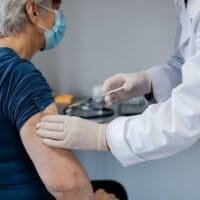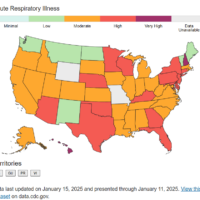As health officials predict a “national surge” in omicron cases, President Joe Biden on Tuesday announced plans to distribute a half-billion free, at-home COVID-19 tests and provide more help for strained hospitals.
Biden assured Americans that despite this latest surge of variant, the nation is more prepared than it was last March.
“This is not March of 2020,” he said. “Two hundred million people are fully vaccinated. We’re prepared. We know more.”
In Kentucky, 2.7 million Kentuckians, or 62% of the total population, have received at least one dose of a vaccine; 2.4 million, or 54% of the total population, are fully vaccinated; and 784,270 people, or 18% of the total population, have received booster shots
Biden’s plan also aims to expand access to vaccination sites across the nation. The president told unvaccinated Americans that they have an obligation to get vaccinated, calling it a “patriotic duty” and “an obligation to your country.”
“If you’re not fully vaccinated, you have good reason to be concerned” about the omicron variant, he warned.
The federal government will start delivering the free, rapid COVID-19 tests to homes next month and a website will be set up for Americans to order them, according to a statement.
Gov. Andy Beshear and Health Commissioner Steven Stack have both encouraged Kentuckians to do a rapid COVID-19 test at home or to go get tested just before attending indoor events or traveling this holiday season, but at-home tests are often scarce and are generally expensive, with one report finding they cost upwards of $25 for a pack of two tests in some locations.
The Centers for Disease Control and Prevention has reported that the omicron variant now accounts for 73% of all new coronavirus cases in the United States.
Kentucky reported 2,566 new coronavirus cases Tuesday, bringing the seven-day average to 2,270, up one from Monday. Of today’s cases, 19.6% of them are in people 18 or younger.
The share of Kentuckians testing positive for the virus in the last seven days is 9.33%, up from 9.2% on Monday.
Hospitals reported 1,205 COVID-19 patients, down one from Monday, with 328 in intensive care (up three) and 174 of them on mechanical ventilation (down two).
Eight of the state’s 10 hospital readiness regions are using at least 80% of their intensive care capacity, with six above 90%. The Barren River and Lake Cumberland regions are using the most, at 96.15% and 96.36% respectively. Northern Kentucky dropped from 100% to 92.86%.
Biden’s plan also increases support for hospitals in hard-hit areas to ensure that they will have the personnel, beds and supplies they need to face rising omicron hospitalizations, which is largely occurring among the unvaccinated.
Beshear said Monday that with the exception of a hospital hit by the biggest tornado that ravaged Western Kentucky last week, he had not heard of any Kentucky hospitals eliminating elective procedures at due to an influx of COVID-19 patients.
The state’s seven-day daily infection rate is 45.02 cases per 100,000 residents. Counties with rates more than double that rate were Wolfe, 137.7; Menifee, 107.9; Union, 101.3; Lewis, 101.2; Carroll, 94.1; and Trimble, 92.8. Kentucky’s infection rate ranks 21st among the states and Washington, D.C., according to The New York Times.
As we head into the holidays, 87.5% of the state’s counties are in red on the state infection map, representing those with more than 25 daily cases per 100,000 people, considered a high level of transmission.
The state reported 35 more COVID-19 deaths, bringing the pandemic death toll to 11,882. The seven-day death average is 29.
Melissa Patrick is a reporter for Kentucky Health News, an independent news service of the Institute for Rural Journalism and Community Issues, based in the School of Journalism and Media at the University of Kentucky, with support from the Foundation for a Healthy Kentucky. She has received several competitive fellowships, including the 2016-17 Nursing and Health Care Workforce Media Fellow of the Center for Health, Media & Policy, which allowed her to focus on and write about nursing workforce issues in Kentucky; and the year-long Association of Health Care Journalists 2017-18 Regional Health Journalism Program fellowship. She is a former registered nurse and holds degrees in journalism and community leadership and development from UK.






